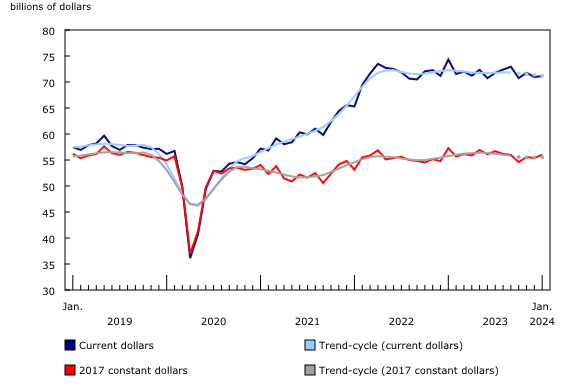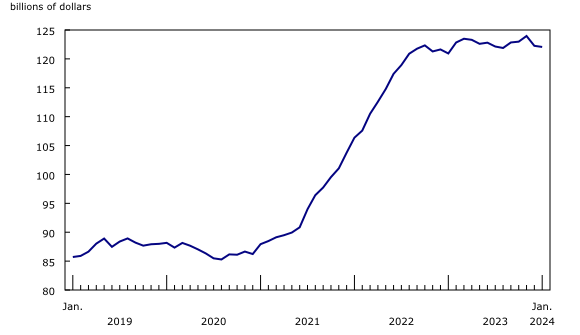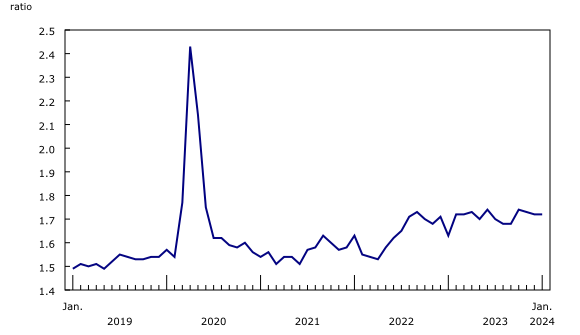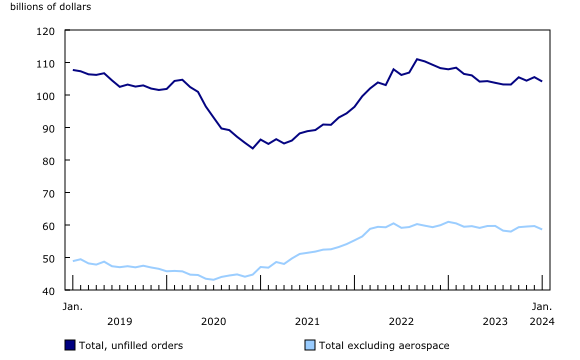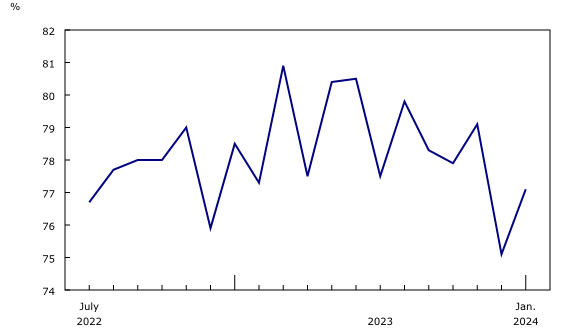Monthly Survey of Manufacturing, January 2024
Released: 2024-03-14
Manufacturing sales rose 0.2% to $71.1 billion in January, on higher sales in 11 of the 21 subsectors, led by the transportation equipment (+4.3%) and chemical (+3.5%) subsectors. The aerospace product and parts industry group (-16.7%) posted the largest decline.
Sales in constant dollars rose 1.1% in January, while the Industrial Product Price Index edged down 0.1%.
Motor vehicle and chemical sales lead increase in January
Following five consecutive monthly declines, sales in the motor vehicle industry group rose 19.6% to $5.3 billion in January. Production resumed in some auto assembly plants in January, after several months of downtime for retooling in 2023. Year over year, sales of motor vehicles were up 7.7% in January, while exports of motor vehicles and parts rose 1.6%.
Sales of chemical products rose 3.5% from December to $5.6 billion in January, on widespread gains in six of the seven industry groups, led by pesticide, fertilizer and other agricultural chemical manufacturing (+68.1%). Despite the monthly increase, total sales of chemical products declined 2.2% year over year in January.
Production in the aerospace product and parts industry group posted the largest monthly decrease, declining 16.7% to $2.1 billion in January. The decline in January followed the largest production on record of aerospace products in December. Exports of aircraft, aircraft engines and aircraft parts decreased 15.2% in January.
Ontario posts the largest sales increase
Manufacturing sales increased in seven provinces in January, led by Ontario and New Brunswick. Sales in Quebec posted the largest decline.
Sales in Ontario rose 3.8% to $32.2 billion in January, led by higher sales of motor vehicles (+21.8%) and chemical products (+10.1%). The gains were partially offset by a 3.7% decline in sales of petroleum and coal products. Motor vehicle manufacturing also contributed to the higher sales in Windsor (+59.6%) and Toronto (+1.5%) in January.
In New Brunswick, sales increased 4.2% to $2.1 billion in January, largely on higher sales of non-durable goods (+5.4%). Despite the increase during the month, total sales in New Brunswick were down 6.1% on a year-over-year basis in January.
In Quebec, sales fell 4.2% from December to $17.3 billion in January, following two consecutive monthly increases. Lower production of aerospace product and parts (-20.6%) as well as lower sales of primary metals (-8.6%) were mainly responsible for this decline. The aerospace product and part industry group also contributed to a decline in total sales in Montréal (-4.2%) in January.
Total inventories decline
Total inventories decreased 0.2% to $122.1 billion in January, following a 1.4% decline in December, due to lower raw material inventories (-1.2%). Lower inventories of primary metals (-4.2%) and petroleum and coal (-4.5%) were mainly responsible for the decline.
The inventory-to-sales ratio was unchanged, at 1.72 in January. This ratio measures the time, in months, that would be required to exhaust inventories if sales were to remain at their current level.
Unfilled orders decrease
The total value of unfilled orders declined 1.3% to $104.2 billion in January, largely on a 2.2% decrease in unfilled orders of transportation equipment.
Capacity utilization rate increases
The capacity utilization rate (not seasonally adjusted) for the total manufacturing sector increased from 75.1% in December to 77.1% in January, mainly on higher production.
Capacity utilization rates increased in the chemical (+7.5 percentage points) and transportation equipment (+3.7 percentage points) subsectors. The gains were partly offset by lower capacity utilization rates in the non-metallic mineral (-7.1 percentage points) and computer and electronic product (-6.1 percentage points) subsectors.
Did you know we have a mobile app?
Get timely access to data right at your fingertips by downloading the StatsCAN app, available for free on the App Store and on Google Play.
Sustainable development goals
On January 1, 2016, the world officially began implementing the 2030 Agenda for Sustainable Development—the United Nations' transformative plan of action that addresses urgent global challenges over the following 15 years. The plan is based on 17 specific sustainable development goals.
The Monthly Survey of Manufacturing is an example of how Statistics Canada supports the reporting on the global sustainable development goals. This release will be used to help measure the following goal:

Note to readers
Monthly data in this release are seasonally adjusted and are expressed in current dollars, unless otherwise specified.
Seasonally adjusted data are data that have been modified to eliminate the effect of seasonal and calendar influences to allow for more meaningful comparisons of economic conditions from period to period. For more information on seasonal adjustment, see Seasonally adjusted data – Frequently asked questions.
Trend-cycle estimates are included in selected charts as a complement to the seasonally adjusted series. These data represent a smoothed version of the seasonally adjusted time series and provide information on longer-term movements, including changes in direction underlying the series. For information on trend-cycle data, see Trend-cycle estimates – Frequently asked questions.
Both seasonally adjusted data and trend-cycle estimates are subject to revision as additional observations become available. These revisions could be large and could even lead to a reversal of movement, especially for reference months near the end of the series or during periods of economic disruption.
Non-durable goods industries include food; beverage and tobacco products; textile mills; textile product mills; apparel; leather and allied products; paper; printing and related support activities; petroleum and coal products; chemicals; and plastics and rubber products.
Durable goods industries include wood products; non-metallic mineral products; primary metals; fabricated metal products; machinery; computer and electronic products; electrical equipment, appliances and components; transportation equipment; furniture and related products; and miscellaneous manufacturing.
Production-based industries
For the aerospace and shipbuilding industry groups, the value of production is used instead of the value of sales of goods manufactured. The value of production is calculated by adjusting monthly sales of goods manufactured by the monthly change in inventories of goods in process and finished products manufactured. The value of production is used because of the extended period of time that it normally takes to manufacture products in these industries.
Unfilled orders are a stock of orders that will contribute to future sales, assuming that the orders are not cancelled.
New orders are those received, whether sold in the current month or not. New orders are measured as the sum of sales for the current month plus the change in unfilled orders from the previous month to the current month.
Manufacturers reporting sales, inventories and unfilled orders in US dollars
Some Canadian manufacturers report sales, inventories and unfilled orders in US dollars. These data are then converted to Canadian dollars as part of the data production cycle.
For sales, based on the assumption that they occur throughout the month, the average monthly exchange rate for the reference month established by the Bank of Canada is used for the conversion. The monthly average exchange rate is available in table 33-10-0163-01. Inventories and unfilled orders are reported at the end of the reference period. For most respondents, the daily average exchange rate on the last working day of the month is used for the conversion of these variables.
However, some manufacturers choose to report their data as of a day other than the last working day of the month. In these instances, the daily average exchange rate on the day selected by the respondent is used. Note that because of exchange rate fluctuations, the daily average exchange rate on the day selected by the respondent can differ from both the exchange rate on the last working day of the month and the monthly average exchange rate. Daily average exchange rate data are available in table 33-10-0036-01.
Revision policy
Each month, the Monthly Survey of Manufacturing releases preliminary data for the reference month and revised data for the previous three months. Revisions are made to reflect new information provided by respondents and updates to administrative data.
Once a year, a revision project is undertaken to revise multiple years of data.
Real-time data tables
Real-time data tables 16-10-0118-01, 16-10-0119-01, 16-10-0014-01 and 16-10-0015-01 will be updated on March 22.
Next release
Data from the Monthly Survey of Manufacturing for February will be released on April 15.
Contact information
For more information, or to enquire about the concepts, methods or data quality of this release, contact us (toll-free 1-800-263-1136; 514-283-8300; infostats@statcan.gc.ca) or Media Relations (statcan.mediahotline-ligneinfomedias.statcan@statcan.gc.ca).
- Date modified:



